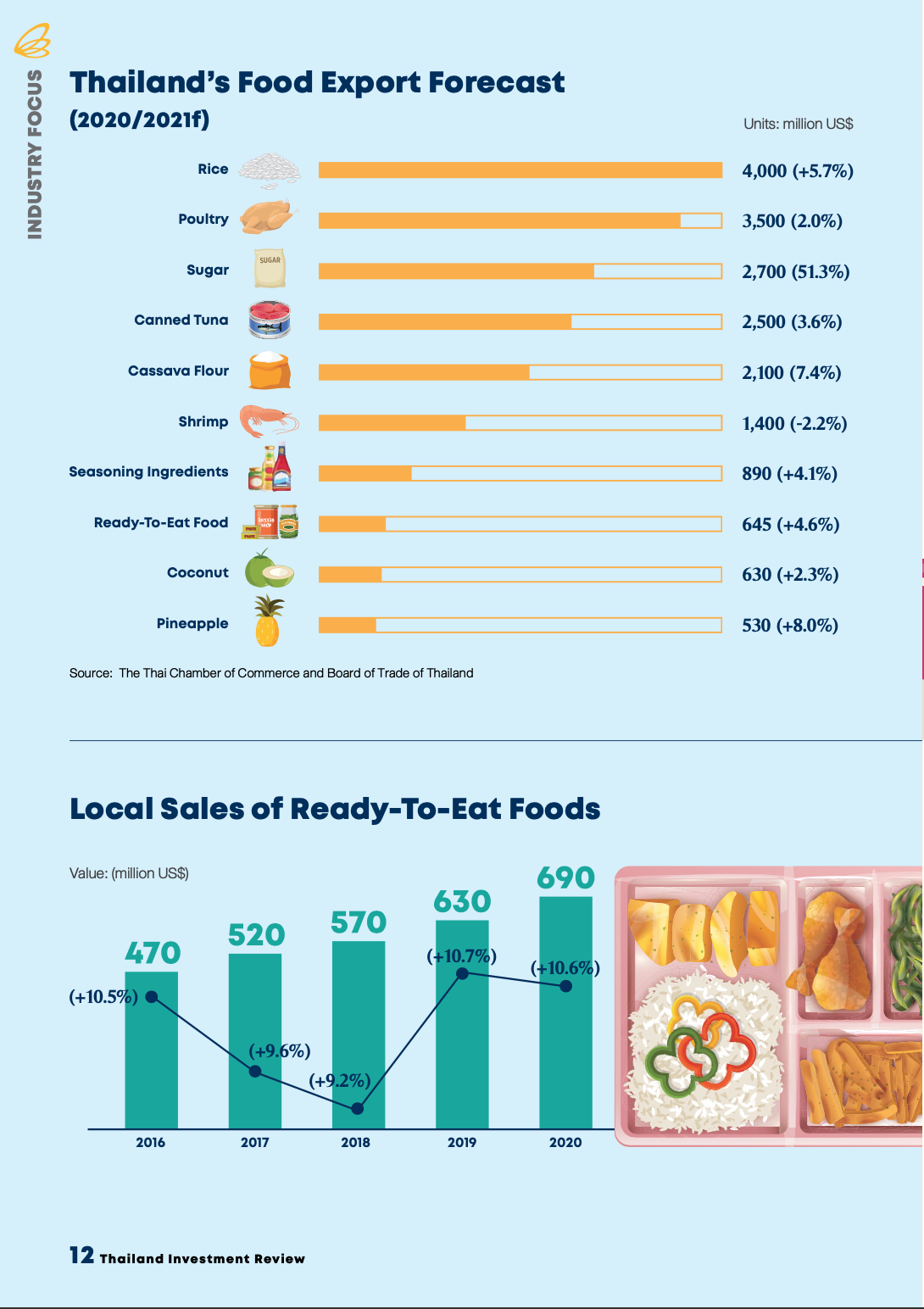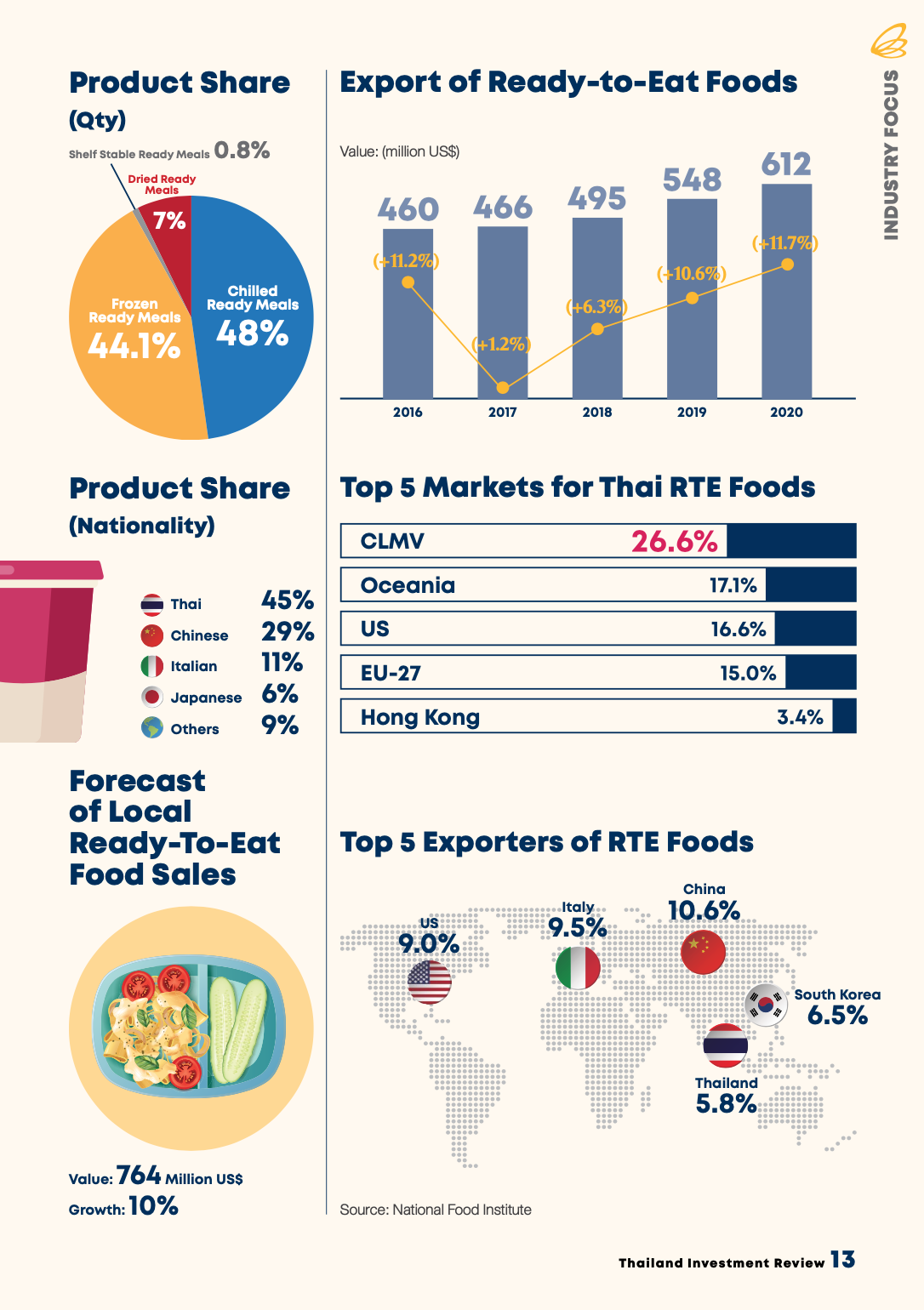
Thailand’s food exporters have found opportunities in the midst of the current crisis brought on by the COVID-19 pandemic. As consumers worldwide visit supermarkets and dine in restaurants less often, they are buying more processed and canned foods to cook at home as well as more ready-to-eat foods.
Thailand recorded a healthy growth in the export of processed foods such as fruits and vegetables and canned seafood, which is in part attributed to economic recovery in those buying countries. The trend has highlighted the strength and diversity of Thailand’s food supply chain, which is serving the country’s goal of producing foods to cater to the growing demand among global consumers for nutritious and functional foods that serve their specific needs.
Healthy Food Exports
While the pandemic has adversely affected world trade, Thailand has recorded healthy growth in the exports of foods and products that are associated with the new normal, such as smart electronics, furniture and decorative items as well as medical devices.
Official data from the Ministry of Commerce shows that Thailand’s total export volume contracted by 6% in 2020, with the market share in global food export products standing at 2.3%. Against the backdrop of the pandemic, fresh, frozen and dried fruits grew by 14%; canned and processed fruits by 2%; soup powder by 30%; frozen poultry by 15%; processed fruits by 8%; seasoning sauces by 8%; canned and processed seafood by 5%; non-alcoholic beverages by 2%; and pet foods by 19%. Data from the Thai Food Processors’ Association showed that exports of ready-to-eat food grew 6% by volume in 2020. Asian markets, including China, Malaysia, Hong Kong, Singapore, Russia, and the CLMV group of countries (Cambodia, Laos, Myanmar and Vietnam) were among the key importers of Thai food products in 2020.
Thailand’s food export performance in 2020 has been in line with the government’s development plan for the industry, which focuses on high value food products, or the so-called “Food for the Future” due to its potential for generating higher outputs and broader impacts on the country’s industrial supply chain.
The government’s development targets include establishing Thailand among the global top ten food exporters by 2027. Thailand was ranked in 13th place in 2020 and 11th place in 2019, with the US, the Netherlands, Brazil, Germany and China ranked the top five largest food exporters.
Two-thirds of the outputs from Thailand’s US$100 billion food market are sold locally, while the country’s food exports are fairly evenly divided between processed and raw foods.
Based on the forecast for world economic growth of 5.5%, Thailand’s Ministry of Commerce projects an increase in Thai food exports of 7%, with the export of frozen seafood expected to grow by 2% in 2021.
Transparency Reassured
The Thai government has applied blockchain technology that enables the traceability of locally produced food products. By scanning QR codes and trace manufacturing lots in the government’s database through the www.TraceThai.com website, buyers of Thai food products can trace the origin and track the journey of the products from harvesting and manufacturing to processing and along the transportation process as well as viewing any organic certificates that have been issued. This initiative will further enhance the credibility and transparency of Thai food products among consumers in terms of safety, environment, and other social issues.
Through cooperation with agencies at the provincial level and its overseas representative office, the Thai government expects to sign in at least 150 agricultural groups for the blockchain project. Furthermore, the Thai government’s ongoing process of streamlining the digital databases of government agencies will better facilitate Thailand’s food and farm product development.
Placing top priority on gaining the trust of global consumers in exported Thai food products, the Thai government has also introduced the “Thailand Delivers with Safety” campaign to step up monitoring of the measures implemented by local food producers and logistics service providers to prevent COVID-19 virus contamination of frozen foods and other food products.
With Thai foods having become well-recognised globally for their high safety and quality standards through compliance with GMP, HACPP and GAP, the country’s food producers are joining a “quality plus” campaign which is intended to encourage all food producers to improve their quality assurance standards.
Future in Hand
The global mainstreaming of plant-based meat is happening not only within the vegan and vegetarian communities, but also among consumers who are increasingly focusing on health impacts and solutions to climate change. Plant-based meat also offers a more affordable protein alternative.
This global shift, which is highlighted by the entry of plant-based meat in major global food chains, points to a favourable future for Thailand as not only a major producer of agricultural products such as beans, fruits, vegetables, herbs, cassava, corn and rice but also a promising producer of future food.
Tapping into this new trend, food startups and corporations in Thailand have rolled out plant-based meat produced from various materials such as mushroom, jackfruit, rice, coconut, beetroot and beans, to serve both local and global markets.
A study by the National Science Technology and Innovation Policy Office (STI) showed that the food industry is the second largest industrial sector investing in R&D, after the auto industry. The R&D activities in the food industry cover a wide range of areas, including automated production processes, packaging development, consumer behaviour and new product development, with a value of US$ 530 million in 2018. Many enterprises are now establishing R&D centres, either on their own premises or in science parks.
According to Food Innopolis, approximately 25% of Thai food researchers have expertise in grains, cereals and legumes, followed by 17% in functional food; 13% in vegetables and mushrooms; 12% each in seafood and meat; 8% each in dairy, herbs, spices and essential oils; and the remainder in juice, sugar and tapioca starch.


